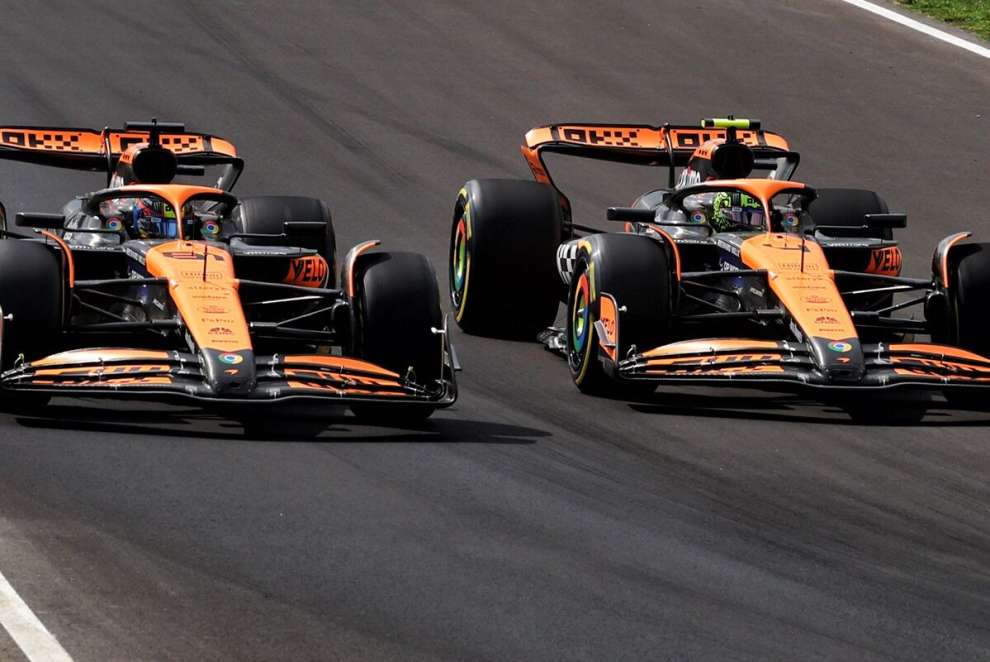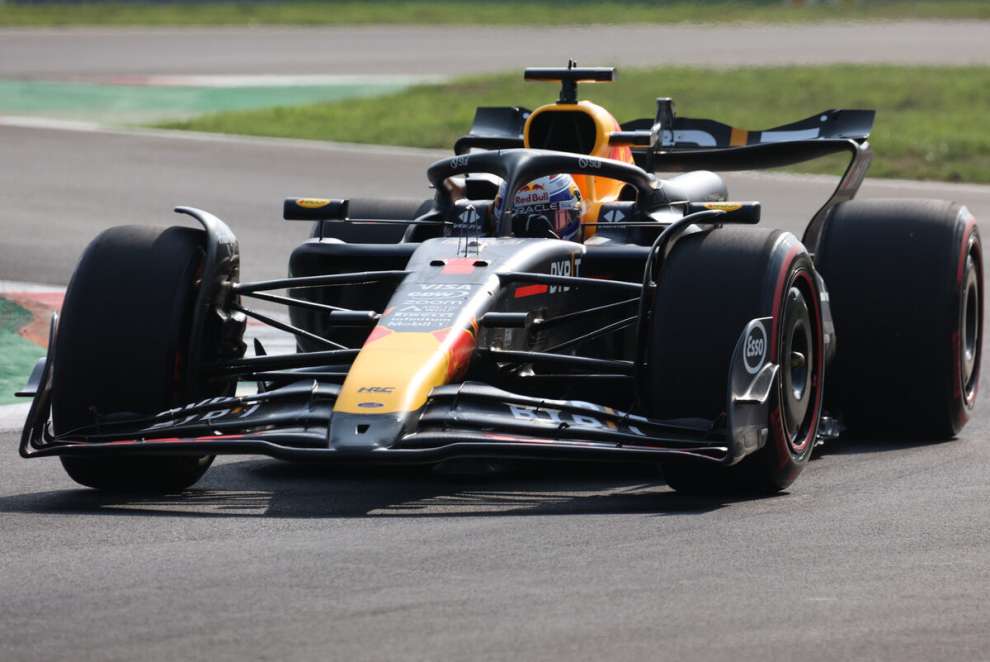By Carlo Platella
Ferrari ends its home weekend as it began it: as a protagonist. The Prancing Horse had already earned the spotlight on Friday, unveiling the long-awaited package of updates. However, the key to its home success is not the developments, but the human merits of a team and a driver able to read a race that has never been so nebulous in Monza, thanks to the recent works at the Autodromo necessary for confirmation in the calendar.
Friendly asphalt
Already on the eve of the race, the complaints of the drivers stand out for the flattening of the kerbs, especially those of the Variante Ascari. A change that is welcomed by the standard-bearers of the Prancing Horse, aware of the difficulties of the SF-24 to digest the bumps at high speeds. The most important novelty however is the new asphaltsmoother, darker and therefore warmer than the previous one. Characteristics that make the tires slip and tear superficially, a dynamic commonly known as graining.
Already on Friday, a picture of great uncertainty emerges between a one- or two-stop race, so much so that the teams are forced to keep both sets of hard tyres for the race, without therefore testing them in the simulations of the first day, which were also carried out on a track that still has little rubber. The only certainty is the need to manage graining, an area in which McLaren still does not excel according to Andrea Stella: “I think our car tends to be very gentle on the rear tyres, but when we face graining on the front we are aggressive and that made us a little nervous.”
Ferrari for its part is aware that it can count on a car that is equally excellent at preserving the rear in traction, but above all effective in managing front graining. A quality that had already emerged in the convincing performances of Las Vegas in 2023 and Melbourne at the start of the season. The Prancing Horse feels encouraged to focus on an aerodynamically lighter configuration compared to McLaren, which instead on Friday afternoon abandoned the new rear wing brought to Monza in favor of the Spa specification.
The race
Saturday’s qualifying and the hectic start, with George Russell’s mistake at the First Variant, outline a direct challenge between Ferrari and McLaren. The excellent competitiveness of the Reds is immediately evident, with Leclerc able to stay in Oscar Piastri’s slipstream for about ten laps despite the disturbance of the dirty air. “I think Leclerc was as fast as the McLarens today”acknowledges Andrea Stella. The initial aggression of the Monegasque, however, costs him greater tyre degradation, accumulating half a second per lap once he lost the DRS tow.

The Ferrari pit wall, however, is unfazed, aware of the excellent pace and potential of the SF-24, as well as the difficulties of its rivals. “The race was strange because we left to go on a single stopbut then McLaren pushed harder than expected in the first stint”, explains Vasseur. “Norris went into crisis before us, so much so that we had to focus on the double stop. We preferred to cover him and stay on their same strategy, because at that point we had the feeling of having an advantage on the tyres”.
Change of program
After the first round of pit stops, the two McLarens continued at an aggressive pace, with the intention of stopping again. Piastri’s pace was eloquent, with 9 of the 20 laps of the second stint oscillating between 1’23”0 and 1’23”2, carrying on an aggressive driving style that made the second tyre change inevitable. “In hindsight, especially with Piastri, if after the first pit stop we had driven the car with a single stop as the objective, I think that victory would have been possible”Stella’s analysis.
Initially Ferrari complied with McLaren’s plans for a second stop, but soon realised that they had sufficient graining management to get to the end. Leclerc in fact maintains a more cautious driving style than the competitionconstantly travelling between 1’23”6 and 1’23”7, only dropping to 1’23”2-1’23”3 on 6 occasions, but not before having reached the certainty that the single stop was feasible. “The advantage was such that after ten laps with the hard tyres it was clear to us that we could get to the end. Then you never know, because there can always be a collapse, which however did not arrive”, Vasseur reveals.

An almost risky move, but it is It is precisely the uncertainty that plays in Leclerc’s favourkeeping him from being too conservative like his teammate. “Maybe Sainz understood a little earlier that it was possible to make a pit stop and cautiously pushed less. Often then it happens that in the end you ask yourself why you didn’t push more,” says the Team Principal. Another little help to Leclerc comes from the sky, with the clouds cooling the track by about ten degrees compared to the start, limiting overheating, sliding and graining of the tyres. The final result is another historic success for the Prancing Horse on its home curves.
Bull in crisis
The Ferrari joys are contrasted by Verstappen’s resignation, who does not hesitate to define “undriveable” his RB20. According to Christian Horner, the European season has exposed an intrinsic problem in the car that has been present since the beginning of the year, but has not yet been highlighted. Development has progressively “disconnected the two axes” of the RB20, with a car that now doesn’t want to turn. Drivers are left with no choice but to apply more steering angle, increasing the front end overheating and generating further understeer, in a vicious circle that only gets worse if graining also occurs, as happened at Monza.

Horner refers to a problem that is only visible on the track, with the world champions using Friday at Monza to compare the latest surface with that of the start of the season. “Our wind tunnel doesn’t show it, but the track says otherwise.”. The perfect storm for Red Bull took shape in Monza, with the mix of slow and fast corners making it even more difficult to find the right balance for all the routes.
Added to this is the most aerodynamic configuration of the year. “Running with more aerodynamic load perhaps helps hide the balance problems we have”reflects the Team Principal. The world champions then find themselves having to deal with the development resources that are now running out. The failure to arrive in Monza of a low-downforce wing will be felt again, in a calendar that still includes the very fast Baku and Las Vegas.
Open World Cup
The Monza result outlines a World constructors championship wide openwith three teams separated by about forty points. The race now goes to Baku and Singapore, two street tracks with slow, low-speed corners where Ferrari excelled at the start of the year and which could also relieve Red Bull of its balance problems, but not of the difficulties on the kerbs highlighted in Monte Carlo. McLaren, on the other hand, does not fear the comparison with the straights of Baku and then again in Las Vegas. “Before Monza we were cautious, but now I think McLaren can compete even on tracks where we were not competitive last year,” acknowledges Andrea Stella. A World Championship in which Mercedes will play the role of fourth wheel, colorless in Monza, but ready to return to the top in a championship with continuous reversals of front and never so exciting.
#Analysis #Fast #versatile #courageous #Ferrari #conquered #Monza